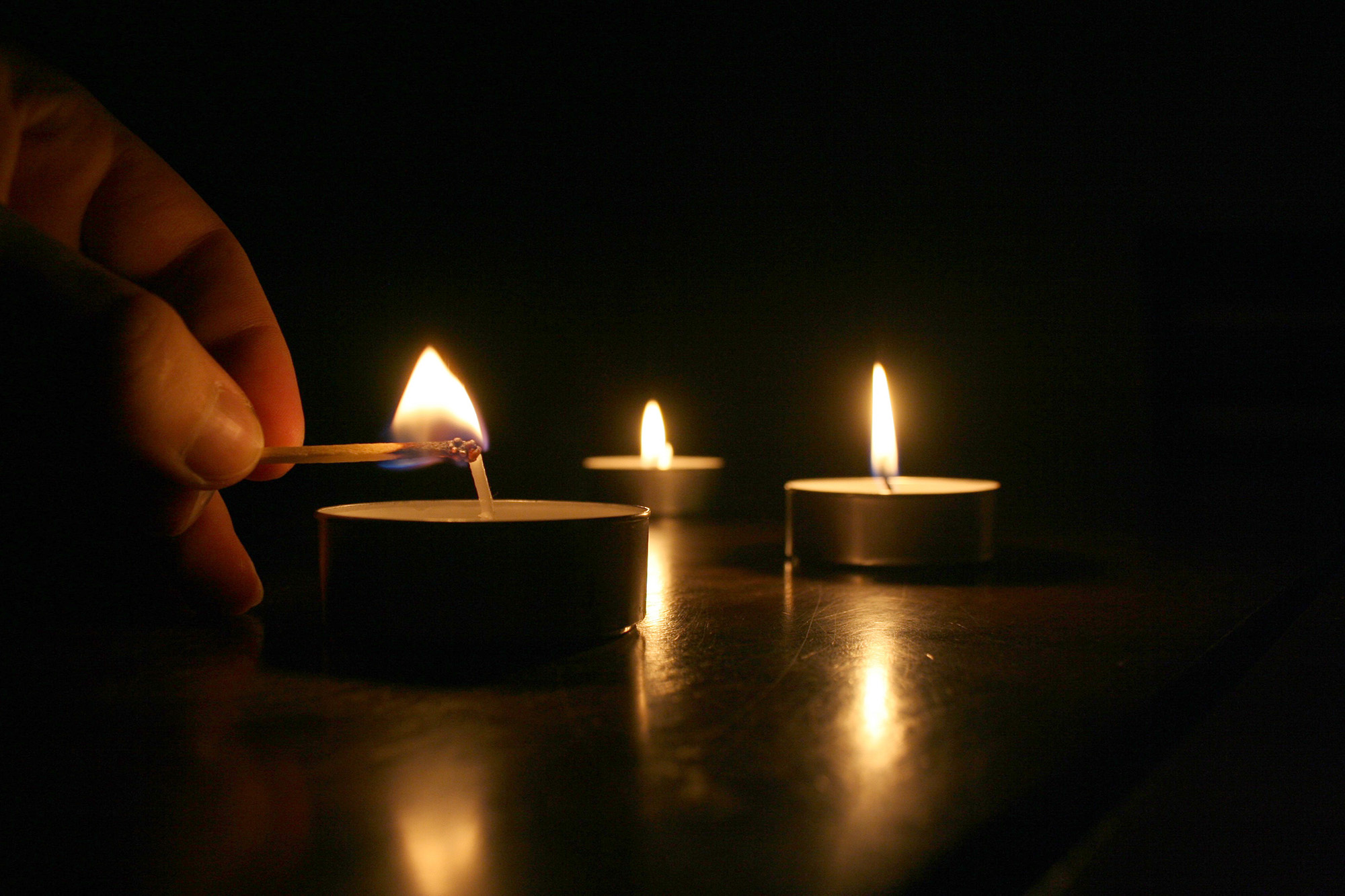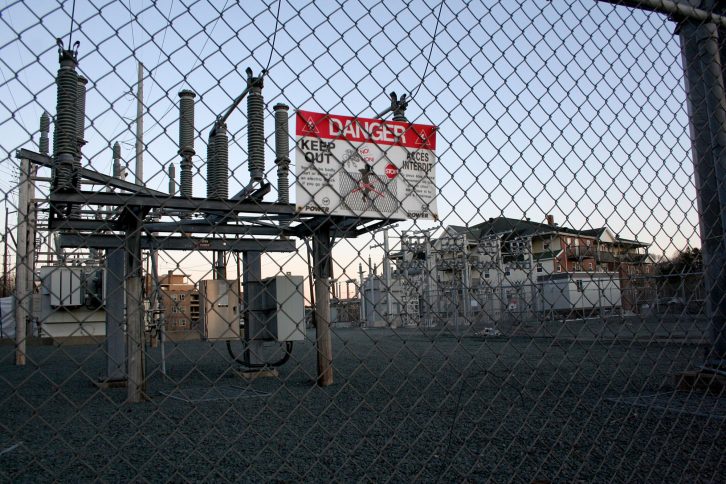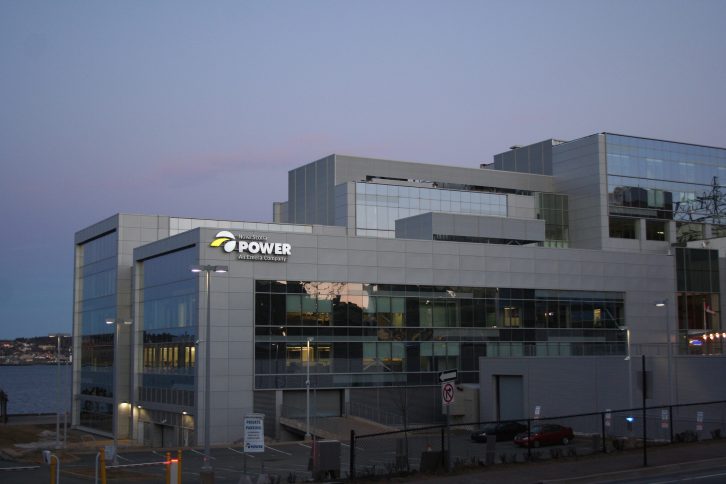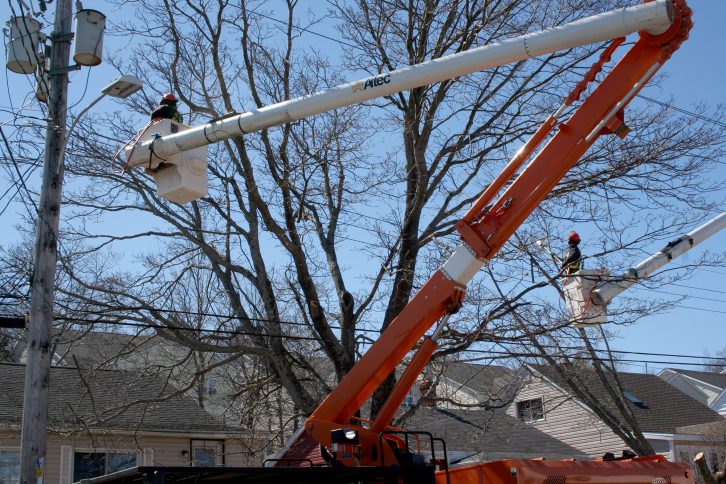Nova Scotia Power
The problem with power

Can the lights stay on in Nova Scotia?
For more than 30 years, Doucette’s Market & Eatery has been a place in Ingonish Beach, N.S., where people can buy groceries, order cakes and enjoy a meal or cup of coffee.
Between Cape Smokey Provincial Park and the Cape Breton Highlands, Doucette’s sits on the corner where Ford Road meets the winding Cabot Trail, approximately 120 metres up the street from the volunteer fire station and C&J Computers. If you pop into the shop, it’s likely owners Ken and Trina Doucette will be around — because they’re afraid to leave.
“It seems like the minute we leave town, the power goes out,” Trina Doucette said in an interview. “Everyone north of Smokey pretty much has a generator.”
While Trina does not record when outages occur, she estimates that they lose power up to 20 times per year, with each outage lasting between six and 10 hours.
“Some months we lose it a lot, others not at all,” she said.
In the event of an outage, Ken and Trina have to be at the shop to switch power over to the generator, then re-rig their equipment until the power comes back. “The generator won’t run everything, so we have to put on a freezer for a while, then shut that one off, put a different one on — just to keep everything frozen,” Trina said.
They manage to stay open during outages, keeping business relatively steady. But it’s stressful because the store could lose “thousands of dollars’ worth of inventory” when the power goes out.
An analysis of Nova Scotia Power Inc. data shows that Doucette’s Market is not an isolated case.

caption
This substation is one of hundreds Nova Scotia Power runs in the province.About 20 kilometres south of Doucette’s is a small community called Wreck Cove. For years, it has had the province’s worst performing local power circuits; it sits along the coastline and is exposed.
Wreck Cove resident John Matthews made losing power seem like a normal inconvenience during an interview. When the lights go out, he calls Nova Scotia Power for their electricity-restoration estimate, then waits it out in his home, which is equipped with a generator and wood stove.
Matthews said he has never made a formal complaint to anyone.
Annual Performance
Since November 2016, the power company has had to report its annual performance to the Nova Scotia Utility and Review Board, the utility’s regulating body. According to the 2018 performance standards annual report, there are several circuits in counties such as Lunenburg, Cumberland and Halifax, where Nova Scotia Power customers experienced more than four outages on average in 2018. According to the same data, customers in communities such as Wreck Cove, Upper Musquodoboit and Upper Burlington, could be without power for nearly a day, if not more.
Since 2013, the number of circuits suffering from an average of at least four outages has declined, but the average number and duration of outages across the entire province have increased.
Of note, the circuit-performance data that Nova Scotia Power reports to the utility board does not include significant outages caused by weather. Those types of events are deemed major event days or extreme event days. According to the 2018 performance standards annual report, the “threshold for a major event day is 165,849 CHI (customer hours of interruption) and the threshold for an extreme event day is 1,109,000 CHI.”
In 2017, those thresholds were 157,127 for major events days and 1,075,386 for extreme event days. That year, there were four major event days and one extreme event day — the wind storm that hit Nova Scotia on Christmas Day 2017 and caused 158,000 individual outages. News reports told of half-cooked turkey dinners and families snuggling close to each other during the night because temperatures were so cold.
In 2018, there were six major event days and two extreme event days.
A quarter of a million homes
The most recent extreme event day was Nov. 29, 2018, when approximately 250,000 homes and businesses — half of Nova Scotia Power’s customers — lost power after a snow storm hit the northeastern part of the province. News reports said it was the worst outage since hurricane Juan hit on Sep. 29, 2003, which caused 300,000 outages.
The power company said the November 2018 storm saw wind and snow pull down one of four high-voltage transmission lines that carry electricity from three power plants in Cape Breton to mainland Nova Scotia. In news reports, the company’s CEO, Karen Hutt, said the three remaining lines could have done the job, but the sagging wires went offline when they touched each other. The outage was compounded by another in Memramcook, N.B., where a transmission line links the New Brunswick and Nova Scotia power systems.
“We pay some of the highest power rates in the country; we expect that power. When it goes out … it needs to come back,” Progressive Conservative Leader Tim Houston was quoted saying.
“It says something pretty serious about grid maintenance as a whole,” Nova Scotia NDP Leader Gary Burrill said at the time. “When we have this level of infrastructure grid failure … why wouldn’t any normal person think, ‘Gosh, something is wrong here.”‘
Premier Stephen McNeil deferred any questions regarding the Liberals’ response to the outage to the utility and review board.
Matt Drover, director of regional operations for Nova Scotia Power, said in an interview that customers’ expectations change every year, as society becomes more reliant on electricity. He said the company is doing everything it can to keep the lights on.

caption
Matt Drover, director of regional operations for Nova Scotia Power.According to Nova Scotia Power, outages are caused by storms and high winds, snow or ice buildup on lines or equipment, lightning, salt contamination, motor vehicle accidents involving their equipment, equipment failure, construction and even animals. But the primary cause is trees.
“We do have a province that is full of trees,” Drover said.
“The reality is there are a lot of cases where we are unable to remove those trees. But we make prudent investments every year, to make sure we improve reliability for people.”
Drover said that problems arise when Nova Scotia is hit with winds of at least 90 km/h. Winds so strong can push trees onto power lines, which Drover says are often built through wooded areas. Heavy snow and ice can also fell trees.
The utility cannot control the weather, which, due to global climate change, is becoming more severe. But another issue for Nova Scotia Power is that they cannot operate on private property without permission from the landowner.
“In a lot of cases, customers want to keep their trees, even if they know it’s going to cause an outage,” Drover said.
“There is no situation where a customer losing power is a good news story for us. But in cases where a land owner will not give us permission to remove the tree, we have no prescriptive rights to go in there and be able to remove it ourselves, unless it poses an immediate safety concern for the line.”
Safety concerns would include if a tree was about to fall on a line
Playing catch-up
Since 2010, legislation has been implemented to improve Nova Scotia’s electrical system. Michel Samson, the Liberal minister of energy until 2017, said in an interview that there were a number of issues that needed to be addressed, so recent legislation shows the provincial government playing catch-up.
During the 2013 provincial electoral race, “Nova Scotia Power was a hot topic in Nova Scotia for all the wrong reasons,” Samson said.
Rates were increasing almost on an annual basis, but reliability was also an issue — even more than it is now. According to Nova Scotia Power circuit data, in 2013, customers along seven different circuits in Nova Scotia — including a circuit in Spryfield — experienced at least 10 outages on average. In 2013, there were 33 circuits whose average outage duration was at least 12 hours.
In 2018, only one circuit in Nova Scotia averaged double-figure frequency and only 17 circuits outage duration averaged at least 12 hours.
Shortly after the 2013 election, the provincial government passed the Electricity Reform Act, forcing a comprehensive review of the province’s electricity system, including a public consultation. The Department of Energy report said it consulted more than 1,300 Nova Scotians in 2014.
On Dec. 18, 2015, the Electricity Plan Implementation Act received royal assent. The rate stability plan stemmed from this bill, allowing Nova Scotia Power customers to know the exact annual increase of rates over a three-year period. Chapter 31 of the bill tasked the utility board with creating reliability performance standards for the province’s electrical system, using metrics best suited for Nova Scotia.
No standards
“There were no standards on which to judge Nova Scotia Power’s performance, when it came to the reliability… and, more importantly, restoration of power when there had been an outage,” Samson said.
The utility board consulted with London Economics International, a global economic, financial and strategic advisory firm specializing in energy and infrastructure. In November 2016, the board confirmed the standards and metrics.
System reliability would be measured by the average number and duration of outages each customer experiences in a year, as well as the average number and duration of outages customers connected to a specific circuit experience in a year.
According to Nova Scotia Power, generating plants make electricity, which is then sent to substations in communities all over Nova Scotia. These substations transform the voltage from high to low and send it through “feeder” lines (circuits). From each substation stems a handful of circuits, which spread out and each serve customers. Knowing how many outages hit each circuit, and how long they last, are crucial metrics for learning which customers are most affected. The other metrics give an overall average.
Nova Scotia Power must restore a certain percentage of customers within 48 hours of a major or extreme event day. In 2018, Nova Scotia Power had target reconnection rates of 87 per cent and 66 per cent of the time, respectively. It almost always met those targets.
The utility must notify customers within four hours of the decision to open the Emergency Operations Centre, keep customers updated on restoration time as soon as new estimates are made, and answer at least 85 per cent of telephone calls within 45 seconds at the customer care centre, during severe outage events. The polite disconnect call rate cannot exceed 10 per cent.
There are also performance standards for updating the live outage map.
Nova Scotia is the only Atlantic province with such standards.
“Should the board determine that NSP has failed to meet its performance targets, the board may apply an administrative penalty up to an annual maximum of $1 million, which cannot be recovered from ratepayers,” the utility board said in its 2016 performance standards decision.
Samson said that whenever you’re deciding upon a fine, there’s a balance that needs to be found between deterrence and what a company can reasonably pay.
“Any shareholders of any company being told they need to pay a million dollars absolutely are not going to be pleased, and are going to demand accountability from management,” Samson said.
Progressive Conservative Leader Tim Houston was vocal about the million-dollar figure being too low during the second reading of the Electricity Plan Implementation Act. In an interview, Houston said he believes Nova Scotia Power wants to provide the best service possible to its customers. His concern, however, is if there are situations in which the utility opts to pay the fine because it would be less expensive than meeting the required standard.

caption
Nova Scotia PC Leader Tim Houston is concerned $1 million fine is not enough for Nova Scotia Power.“Companies make financial decisions driven — to at least some degree — by financial impact,” Houston said.
“If the intent of the legislation was to encourage certain activity on the power company, I don’t know if that fine would do it,” Houston said.
“A million dollars is a lot for me, and certainly is for most people; probably not that much money for a company the size of Nova Scotia Power.”
According to Emera Inc.’s 2018 annual report, Nova Scotia Power had a net income of approximately $131 million last year. Emera is the power company’s parent.
Houston has not looked at the data, but did say reliability seems to have improved.
Near monopoly
Nova Scotia Power Inc. has a near monopoly, providing 95 per cent of the generation, transmission and distribution of electricity in Nova Scotia. According to Emera’s 2018 annual report, Nova Scotia Power serves approximately 519,000 residential, commercial and industrial customers. There are six municipalities operating their own transmission and distribution systems, but they still buy electricity from Nova Scotia Power if they don’t generate their own or buy from independent power producers (most of whom supply wind energy).
Nova Scotia Power must serve any customer in Nova Scotia, outside of the six municipal utilities. All customers — regardless of whether they’re in Ingonish Beach or downtown Halifax — pay the same rates and are supposed to have the same access.
According to 2018 circuit data, a circuit in Wreck Cove had the worst performance of any in the province. The average customer linked to this circuit experienced more than 17 outages, each lasting more than 67 hours — nearly three full days.
Lunenburg and Cumberland counties are often hit hard, although Lunenburg was worse in 2018. In terms of outage frequency, six of the province’s worst eight circuits were in Lunenburg. Along those six circuits, the average customer suffered between seven and nine outages, each lasting between 14.5 hours and just under 24 hours.
Circuits in Halifax Regional Municipality also had a rough year. One in Porters Lake had the second-highest average of outages per customer in the province with nine, each lasting longer than 12 hours on average. Some urban areas, such as Maple Street in downtown Dartmouth, experienced frequent outages. Customers linked to a circuit of the Maple Street substation experienced about five outages, each lasting more than eight hours on average.
Map shows circuits in Nova Scotia and their average frequency of outages. Click the arrow to see a legend. Source: Nova Scotia Utility and Review Board/Nova Scotia Power
High rates
According to a comparison of electricity prices done by Hydro Quebec in 2018, Nova Scotia Power customers pay the third-highest rates in Canada. Only Saskatchewan and P.E.I. have higher residential rates.
In Nova Scotia, residential rates have increased by 1.7 per cent each of the last three years. As of Jan.1, 2019, the residential service base charge is $10.83 per month, plus 15.6 cents per kilowatt hour.
Nova Scotia Power’s residential customers using electric-based heating systems or electric in-floor heating systems approved by the utility do have another payment option. This option allows customers to pay less per kilowatt hour during non-peak demand times, non-winter months, weekends and statutory holidays, but the costs of electricity increase during the winter when demand is highest. The base charge is $18.82 per month, while kilowatt hours cost between 8.68 cents and 19.96 cents, depending on the time, day and month.
“Balancing the expectations of consumers concerning NSP’s performance and the level of rate increases can present a challenge to the board,” consultants London Economics International said in their 2016 performance standards paper for the utility board.
The desire for long-term rate stabilization and a reliable system “implies a natural limit on the overall level of performance delivered by NSP,” it added.

caption
NSP provides 95 per cent of the generation, transmission and distribution of electricity in Nova Scotia.Underground power lines
Many Nova Scotians wonder why Nova Scotia Power doesn’t bury the power lines to protect them from trees and storms. In January 2013, the Edison Electric Institute updated its study about burying power lines, Out of Sight, Out of Mind.
It found burying lines does improve system reliability, but doesn’t end outages.
It removes the threat of falling vegetation, along with most weather-related outages, which would result in fewer outages. However, underground lines would still be vulnerable in areas that are prone to flooding. It’s also much harder to find the cause of anoutage when everything is underground.
“When there is a failure, you have to pinpoint where it is,” said Nova Scotia Power’s Matt Drover. He added that, unlike with overhead power lines — where crews can follow the circuit until they actually see the problem — underground ground lines require crews to visit each manhole until the outage is found.
Then there’s footing the bill.
According to the Edison study, burying power lines can be five to 10 times more expensive than installing overhead poles. In 2019 Canadian dollars, the cost of installing overhead power lines can range from approximately $251,300 to $9.4 million per mile in rural areas, from $335,000 to $6.5 million per mile in suburban areas and from $545,000 to $15.9 million per mile in urban areas.
Contrast that with installing underground lines, which ranges from $2 million to $39 million per mile in rural areas, $3.3 million to $43 million per mile in suburban areas and $5 million to $43.3 million per mile in urban areas.
Nova Scotia has 31,800 kilometres of power lines, of which about 45 kilometres are underground.
NSP says the average cost of installing underground lines is $1,000 per metre, $100,000 for each manhole and roughly $500,000 for a vault. The manholes are needed to provide workers a safe entry to access equipment and the vault is installed for underground storage of equipment like transformers and breakers.
Were the province to convert its entire electrical system and go underground, a quick calculation shows the underground power cables alone would cost nearly $32 billion.
The higher costs are due to the materials of underground cables, plus the planning, labour and time it takes to bury power lines. Drover said that there is a lot of rock to dig through in Nova Scotia and cement would have to be poured around the cables to prevent erosion from the rock. This would increase costs as well.
These costs do not include the need for more frequent replacement of the underground cables, since they don’t last as long as overhead poles and cables.
According to estimates by Manitoba Hydro, underground cables can last between 30 to 70 years. Overhead wooden poles can last 75 years, and overhead power lines can last up to 100 years.
Mohamed El-Hawary, an expert on electric power systems at Dalhousie University, says compact, densely populated areas such as Manhattan, New York are better suited for underground power lines because they can afford it.
Manhattan has an estimated population of 1.63 million, living within about 37 square kilometres. Nova Scotia has a population of 953,869 and spans 55,284 square kilometres.
Other solutions
Ultimately, El-Hawary says, whatever steps are taken to make the system more reliable must be cost-effective.
Because trees are the primary cause of outages in the province, Nova Scotia Power invests $20 million annually towards trimming and removing trees.
Drover said this could involve axing a tree completely, simply cutting off certain branches, or spraying herbicide to prevent future growth in areas where trees were torn down. He added that crews work on vegetation year-round, and focus primarily in areas of the province with poor reliability.
“It’s impossible to remove every tree in the province,” Drover said. “So if we can’t address reliability that way, then maybe there are innovative ways that we can work with customers to make sure their power stays on when we have an outage.”

caption
A crew saws branches that were tangled in power lines.The company also invests about $80 million annually in system maintenance and upgrades. One example would be a pilot project on-going in Elmsdale, in Hants County, where they’re testing new Tesla technology. A storage battery called a Powerpack was installed in a neighbourhood substation and ten homes received an energy storage Powerwall.
The Powerpack is fed power from intermittent renewable sources such as wind or solar, and can be charged or discharged at any time. The Powerwalls will automatically discharge in the event of an outage, providing back-up power to the home. The Powerpack can supply power to any customers along the particular Elmsdale circuit, even those without a Powerwall.
NSP says one usage scenario being tested is charging the battery when the wind blows, then discharging the Powerpack during peak load, when customer demand is highest.
Anne and Mac Noble are two of the volunteers for the Elmsdale pilot project. In an interview, Mac said the power has gone out a few times since the Powerwall was installed and the back-up supply immediately kicked in so they didn’t lose electricity.
“It’s so quick that it doesn’t even click the computer off,” he said.
The battery life of the Powerwall depends on how many things are plugged into it. The Nobles have been using electricity as normal during outages. One outage lasted seven hours in the fall and it only used 15 per cent of the battery power.
“But you don’t know how long the power is going to be off, so you don’t do anything extraordinarily stupid,” Mac said.
Smart meters coming
More immediate system changes will start later in 2019, as Nova Scotia Power switches its customers to smart meters. According to the company, this is a $133 million investment approved by the utility and review board. Installation is free for customers.
“Today, without smart meters, the only way we know the power is out is if people call in,” Drover said. “Smart meters will completely revolutionize that.”
According to Nova Scotia Power, both digital and analog meters use electricity fed from the service wire connected to a customer’s home or business. The meter uses minimal electricity to operate and is absorbed as part of Nova Scotia Power’s operational costs. Smart meters will be powered in the same way.
The difference, however, is smart meters are equipped with a private wireless connection to the Nova Scotia Power system. This allows the utility to know exactly when a customer’s power goes out, and allows them to read meters from a computer, rather than sending someone out for a visit every two months.
Drover says that Nova Scotia Power is one of the last utilities to adopt smart meters, which means they have learned from other utilities.
In 2014, Hydro-Québec and Hydro One, in Ontario, launched investigations into unexplained increases in power bills shortly after smart meters were installed. That same year, the Saskatchewan government ordered SaskPower to remove 105,000 smart meters after eight houses somehow caught fire because of the devices.
To avoid those mishaps, Drover said that they will be working closely with Measurement Canada, a federal agency responsible for the accuracy of measuring devices. Once installed, NSP will send employees for the smart meters’ initial readings.
On top of possible malfunctions, Nova Scotia Power will face anti-smart meter advocates such as No Smart Meters In Nova Scotia, who claim that, on top of increased costs to customers, smart meters present health and safety risks. They give no evidence to prove their claims.
Health Canada says that radiation from smart meters does not pose a public health risk. The exposure levels would be similar to being exposed to AM or FM radio signals.
Customers can opt out of smart meter installation — but at a price. The utility board has set two options: customers whose meters are currently read every two months will move to two reads per year, and pay $4 per month. Or, customers whose meters are read each month will continue to have monthly reads, and pay a fee of $22 per month.
That said, Nova Scotia Power needs to apply to and receive approval from the utility board before charging opt-out fees. Customers will not be charged until the province-wide smart meter installation is complete in late 2020.
Meanwhile, back in Ingonish Beach, as Nova Scotia Power tries to find ways to make a more reliable grid, Ken and Trina Doucette, the owners of Doucette’s Market & Eatery, will continue staying near the shop. They’ll keep their shop’s generator full of gas and wait for the next power outage.
Editor's Note
This story has been clarified to make it clear Nova Scotia Power had a target in 2018 of reconnecting 87 per cent and 66 per cent of customers within 48 hours after a major or extreme event day, respectively, and that it met those targets in almost all cases.


C
Christine Bonnar
S
Stephanie Bilodeau